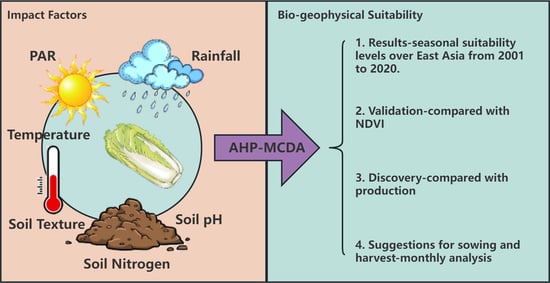Bio-Geophysical Suitability Mapping for Chinese Cabbage of East Asia from 2001 to 2020
Abstract
:1. Introduction
2. Materials and Methods
2.1. Study Area
2.2. Input Factors and Data Process
2.2.1. Solar Suitability
2.2.2. Meteorological Suitability
2.2.3. Agrological Suitability
2.3. Crop Calendar and Ground Truth Production
2.4. Overflow
2.5. Analytic Hierarchy Process–Multi-Criteria Decision Analysis (AHP-MCDA)
3. Results
4. Discussion
4.1. Comparison Analysis between Bio-Geophysical Suitability and NDVI
4.2. Comparison Analysis between Bio-Geophysical Suitability and Production Data
4.3. Monthly Evaluation of Bio-Geophysical Suitability Nationally and Internationally
4.4. Limitations, Uncertainties, and Future Work
5. Conclusions
Supplementary Materials
Author Contributions
Funding
Data Availability Statement
Acknowledgments
Conflicts of Interest
References
- Hu, B.; Shao, S.; Ni, H.; Fu, Z.; Hu, L.; Zhou, Y.; Min, X.X.; She, S.F.; Chen, S.C.; Huang, M.X.; et al. Current status, spatial features, health risks, and potential driving factors of soil heavy metal pollution in China at province level. Environ. Pollut. 2020, 266, 114961. [Google Scholar] [CrossRef]
- Reba, M.; Seto, K.C. A systematic review and assessment of algorithms to detect, characterize, and monitor urban land change. Remote Sens. Environ. 2020, 242, 111739. [Google Scholar] [CrossRef]
- Zhang, Y.; Fu, T.; Chen, X.; Guo, H.; Li, H.; Hu, B. Modelling Cadmium Contents in a Soil–Rice System and Identifying Potential Controls. Land 2022, 11, 617. [Google Scholar] [CrossRef]
- The Word Bank. Agricultural Land (% of Land Area). Available online: https://data.worldbank.org/indicator/AG.LND.AGRI.ZS (accessed on 20 December 2022).
- Akıncı, H.; Özalp, A.Y.; Turgut, B. Agricultural land use suitability analysis using GIS and AHP technique. Comput. Electron. Agric. 2013, 97, 71–82. [Google Scholar] [CrossRef]
- Nurda, N.; Noguchi, R.; Ahamed, T. Change detection and land suitability analysis for extension of potential forest areas in Indonesia using satellite remote sensing and GIS. Forests 2020, 11, 398. [Google Scholar] [CrossRef] [Green Version]
- Habibie, M.I.; Noguchi, R.; Shusuke, M.; Ahamed, T. Land suitability analysis for maize production in Indonesia using satellite remote sensing and GIS-based multicriteria decision support system. GeoJournal 2021, 86, 777–807. [Google Scholar] [CrossRef]
- Kihoro, J.; Bosco, N.J.; Murage, H. Suitability analysis for rice growing sites using a multicriteria evaluation and GIS approach in great Mwea region, Kenya. Springerplus 2013, 2, 265. [Google Scholar] [CrossRef] [Green Version]
- Moeletsi, M.E.; Walker, S. Agroclimatological suitability mapping for dryland maize production in Lesotho. Theor. Appl. Climatol. 2013, 114, 227–236. [Google Scholar] [CrossRef]
- Peter, B.G.; Messina, J.P.; Lin, Z.; Snapp, S.S. Crop climate suitability mapping on the cloud: A geovisualization application for sustainable agriculture. Sci. Rep. 2020, 10, 15487. [Google Scholar] [CrossRef]
- Reganold, J.P.; Papendick, R.I.; Parr, J.F. Sustainable agriculture. Sci. Am. 1990, 262, 112–121. [Google Scholar] [CrossRef] [Green Version]
- Janker, J.; Mann, S.; Rist, S. What is sustainable agriculture? Critical analysis of the international political discourse. Sustainability 2018, 10, 4707. [Google Scholar] [CrossRef] [Green Version]
- Delgado, J.A.; Short, N.M., Jr.; Roberts, D.P.; Vandenberg, B. Big data analysis for sustainable agriculture on a geospatial cloud framework. Front. Sustain. Food Syst. 2019, 3, 54. [Google Scholar] [CrossRef] [Green Version]
- Seelan, S.K.; Laguette, S.; Casady, G.M.; Seielstad, G.A. Remote sensing applications for precision agriculture: A learning community approach. Remote Sens. Environ. 2003, 88, 157–169. [Google Scholar] [CrossRef]
- Huang, J.; Gómez-Dans, J.L.; Huang, H.; Ma, H.; Wu, Q.; Lewis, P.E.; Xie, X. Assimilation of remote sensing into crop growth models: Current status and perspectives. Agric. Forest. Meteorol. 2019, 276, 107609. [Google Scholar] [CrossRef]
- Xia, F.; Hu, B.; Shao, S.; Xu, D.; Zhou, Y.; Huang, M.X.; Li, Y.; Chen, S.C.; Shi, Z. Improvement of Spatial Modeling of Cr, Pb, Cd, As and Ni in Soil Based on Portable X-ray Fluorescence (PXRF) and Geostatistics: A Case Study in East China. Int. J. Environ. Res. Pub. Health 2019, 16, 2694. [Google Scholar] [CrossRef] [Green Version]
- Wang, M.; Feng, C.; Hu, B.; Wang, N.; Xu, J.; Ma, Z.; Peng, J.; Shi, Z. A new framework for reconstructing time series DMSP-OLS nighttime light data using the Improved Stepwise Calibration (ISC) method. Remote Sens. 2022, 14, 4405. [Google Scholar] [CrossRef]
- Bandyopadhyay, S.; Jaiswal, R.K.; Hegde, V.S.; Jayaraman, V. Assessment of land suitability potentials for agriculture using a remote sensing and GIS based approach. Int. J. Remote Sens. 2009, 30, 879–895. [Google Scholar] [CrossRef]
- Baroudy, A.A.E.; Ali, A.M.; Mohamed, E.S.; Moghanm, F.S.; Shokr, M.S.; Savin, I.; Lasaponara, R. Modeling land suitability for rice crop using remote sensing and soil quality indicators: The case study of the nile delta. Sustainability 2020, 12, 9653. [Google Scholar] [CrossRef]
- Binte, M.R.; Noguchi, R.; Ahamed, T. Agricultural land suitability assessment using satellite remote sensing-derived soil-vegetation indices. Land 2021, 10, 223. [Google Scholar] [CrossRef]
- Halder, J.C. Land suitability assessment for crop cultivation by using remote sensing and GIS. J. Geogr. Geol. 2013, 5, 65. [Google Scholar] [CrossRef]
- Islam, M.M.; Ahamed, T.; Noguchi, R. Land suitability and insurance premiums: A GIS-based multicriteria analysis approach for sustainable rice production. Sustainability 2018, 10, 1759. [Google Scholar] [CrossRef]
- Benami, E.; Jin, Z.; Carter, M.R.; Ghosh, A.; Hijmans, R.J.; Hobbs, A.; Kenduiywo, B.; Lobell, D.B. Uniting remote sensing, crop modelling and economics for agricultural risk management. Nat. Rev. Earth Environ. 2021, 2, 140–159. [Google Scholar] [CrossRef]
- Zolekar, R.B.; Bhagat, V.S. Multi-criteria land suitability analysis for agriculture in hilly zone: Remote sensing and GIS approach. Comput. Electron. Agric. 2015, 118, 300–321. [Google Scholar] [CrossRef]
- Seyedmohammadi, J.; Sarmadian, F.; Jafarzadeh, A.A.; McDowell, R.W. Development of a model using matter element, AHP and GIS techniques to assess the suitability of land for agriculture. Geoderma 2019, 352, 80–95. [Google Scholar] [CrossRef]
- Bock, M.; Gasser, P.Y.; Pettapiece, W.W.; Brierley, A.J.; Bootsma, A.; Schut, P.; Neilsen, D.; Smith, C.S. The land suitability rating system is a spatial planning tool to assess crop suitability in Canada. Front. Environ. Sci. 2018, 6, 77. [Google Scholar] [CrossRef] [Green Version]
- Tadesse, M.; Negese, A. Land suitability evaluation for sorghum crop by using GIS and AHP techniques in Agamsa sub-watershed, Ethiopia. Cogent. Food Agric. 2020, 6, 1743624. [Google Scholar] [CrossRef]
- Hashemvand, K.; Takeuchi, W. Assessment of oil palm yield and biophysical suitability in Indonesia and Malaysia. Int. J. Remote Sens. 2020, 41, 8520–8546. [Google Scholar] [CrossRef]
- Mendas, A.; Delali, A. Integration of MultiCriteria Decision Analysis in GIS to develop land suitability for agriculture: Application to durum wheat cultivation in the region of Mleta in Algeria. Comput. Electron. Agric. 2012, 83, 117–126. [Google Scholar] [CrossRef]
- Montgomery, B.; Dragićević, S.; Dujmović, J.; Schmidt, M. A GIS-based Logic Scoring of Preference method for evaluation of land capability and suitability for agriculture. Comput. Electron. Agric. 2016, 124, 340–353. [Google Scholar] [CrossRef]
- Motuma, M.; Suryabhagavan, K.V.; Balakrishnan, M. Land Suitability Analysis for Wheat and Sorghum Crops in Wogdie District, South Wollo, Ethiopia, Using Geospatial Tools. Appl. Geomat. 2016, 8, 57–66. [Google Scholar] [CrossRef]
- Saaty, T.L. Decision making with the analytic hierarchy process. Int. J. Ser. Sci. 2008, 1, 83–98. [Google Scholar] [CrossRef] [Green Version]
- Elaalem, M.; Comber, A.; Fisher, P. A comparison of fuzzy AHP and ideal point methods for evaluating land suitability. Trans. GIS 2011, 15, 329–346. [Google Scholar] [CrossRef]
- Romano, G.; Dal Sasso, P.; Liuzzi, G.T.; Gentile, F. Multi-criteria decision analysis for land suitability mapping in a rural area of Southern Italy. Land Use Policy 2015, 48, 131–143. [Google Scholar] [CrossRef]
- Bozdag, A.; Yavuz, F.; Günay, A.S. AHP and GIS based land suitability analysis for Cihanbeyli (Turkey) County. Environ. Earth Sci. 2016, 75, 813. [Google Scholar] [CrossRef]
- Morales, F., Jr.; de Vries, W.T. Establishment of land use suitability mapping criteria using analytic hierarchy process (AHP) with practitioners and beneficiaries. Land 2021, 10, 235. [Google Scholar] [CrossRef]
- Kim, D.W.; Yun, H.S.; Jeong, S.J.; Kwon, Y.S.; Kim, S.G.; Lee, W.S.; Kim, H.J. Modeling and testing of growth status for Chinese cabbage and white radish with UAV-based RGB imagery. Remote Sens. 2018, 10, 563. [Google Scholar] [CrossRef] [Green Version]
- Lee, C.H.; Lee, D.K.; Ali, M.A.; Kim, P.J. Effects of oyster shell on soil chemical and biological properties and cabbage productivity as a liming materials. Waste Manag. 2008, 28, 2702–2708. [Google Scholar] [CrossRef]
- Wang, S.F. Efficient Cultivation of Cabbage and Radish in Spring and Summer Season; Jindun Publisher: Beijing, China, 2016; pp. 17–29. (In Chinese) [Google Scholar]
- Carlson, T.N.; Ripley, D.A. On the relation between NDVI, fractional vegetation cover, and leaf area index. Remote Sens. Environ. 1997, 62, 241–252. [Google Scholar] [CrossRef]
- De Castro, A.I.; Six, J.; Plant, R.E.; Peña, J.M. Mapping crop calendar events and phenology-related metrics at the parcel level by object-based image analysis (OBIA) of MODIS-NDVI time-series: A case study in central California. Remote Sens. 2018, 10, 1745. [Google Scholar] [CrossRef] [Green Version]
- Nguyen, T.T.H.; De Bie, C.A.J.M.; Ali, A.; Smaling, E.M.A.; Chu, T.H. Mapping the irrigated rice cropping patterns of the Mekong delta, Vietnam, through hyper-temporal SPOT NDVI image analysis. Int. J. Remote Sens. 2012, 33, 415–434. [Google Scholar] [CrossRef]
- Pan, Z.K.; Huang, J.F.; Zhou, Q.B.; Wang, L.M.; Cheng, Y.X.; Zhang, H.K.; Blackburn, G.A.; Liu, J.H. Mapping crop phenology using NDVI time-series derived from HJ-1 A/B data. Int. J. Appl. Earth Obs. 2015, 34, 188–197. [Google Scholar] [CrossRef] [Green Version]
- DeFries, R.S.; Townshend, J.R.G. NDVI-derived land cover classifications at a global scale. Int. J. Remote Sens. 1994, 15, 3567–3586. [Google Scholar] [CrossRef]
- Lu, H.; Guo, Z. Evolution of the monsoon and dry climate in East Asia during late Cenozoic: A review. Sci. China Earth Sci. 2014, 57, 70–79. [Google Scholar] [CrossRef]
- Li, J.; Pu, L.; Zhu, M.; Zhang, J.; Li, P.; Dai, X.; Xu, Y.; Liu, L. Evolution of soil properties following reclamation in coastal areas: A review. Geoderma 2014, 226, 130–139. [Google Scholar] [CrossRef]
- Li, J.W.; Shinnohara, S.; Shimura, H. Chinese Cabbage; Shinohara Shiki Publisher: Tokyo, Japan, 1993; pp. 77–185. (In Japanese) [Google Scholar]
- Oh, S.; Moon, K.H.; Song, E.Y.; Son, I.C.; Koh, S.C. Photosynthesis of Chinese cabbage and radish in response to rising leaf temperature during spring. Hortic. Environ. Biotechnol. 2015, 56, 159–166. [Google Scholar] [CrossRef]
- Cho, J.H.; Suh, J.M.; Jin, K.H.; Kang, J.S.; Hong, C.O.; Lim, W.T.; Lee, S.G. The impacts of high temperature and heavy precipitation amount on winter Chinese cabbage yields. Int. J. Environ. Sci. 2013, 22, 235–242. (In Korean) [Google Scholar] [CrossRef]
- Kim, I.G.; Park, K.J.; Kim, B.J. Analysis of meteorological factors on yield of Chinese cabbage and radish in winter cropping system. Korean J. Agric. For. Meteorol. 2013, 15, 59–66. (In Korean) [Google Scholar] [CrossRef] [Green Version]
- University of California. Drought Tips for Home Gardeners. Available online: https://ucanr.edu/sites/mg-plumas-sierra/WaterManagement// (accessed on 23 September 2022).
- Qu, Z.M.; Qi, X.C.; Wang, J.; Chen, Q.; Li, C.L. Effects of nitrogen application rate and topdressing times on yield and quality of Chinese cabbage and soil nitrogen dynamics. Environ. Pollut. Bioavailab. 2019, 31, 1–8. [Google Scholar] [CrossRef] [Green Version]
- Hu, B.; Xie, M.; Li, H.; Zhao, W.; Hu, J.; Jiang, Y.; Ji, J.; Li, S.; Hong, Y.; Yang, M.; et al. Stoichiometry of soil carbon, nitrogen, and phosphorus in farmland soils in Southern China: Spatial pattern and related dominates. Catena 2022, 217, 106468. [Google Scholar] [CrossRef]
- Hu, B.; Zhou, Q.; He, C.; Duan, L.; Li, W.; Zhang, G.; Ji, W.; Peng, J.; Xie, H. Spatial variability and potential controls of soil organic matter in the Eastern Dongting Lake Plain in southern China. J. Soils Sediments 2021, 21, 2791–2804. [Google Scholar] [CrossRef]
- Li, H.; Van den Bulcke, J.; Mendoza, O.; Deroo, H.; Haesaert, G.; Dewitte, K.; Neve, S.; Sleutel, S. Soil texture controls added organic matter mineralization by regulating soil moisture—Evidence from a field experiment in a maritime climate. Geoderma 2022, 410, 115690. [Google Scholar] [CrossRef]
- Mi, Y.H.; Lu, L.; Liu, H.C. Impact analysis of soil texture on the quality of Chinese cabbage. Southwest. China. J. Agric. Sci. 2012, 25, 1347–1351. (In Chinese) [Google Scholar]
- Guttormsen, G.; Singh, B.R.; Jeng, A.S. Cadmium concentration in vegetable crops grown in a sandy soil as affected by Cd levels in fertilizer and soil pH. Fertil. Res. 1995, 41, 27–32. [Google Scholar] [CrossRef]
- Parker, J.A.; Kenyon, R.V.; Troxel, D.E. Comparison of interpolating methods for image resampling. IEEE Trans. Med. Imaging 1983, 2, 31–39. [Google Scholar] [CrossRef]
- Radočaj, D.; Jurišić, M.; Gašparović, M.; Plaščak, I. Optimal soybean (Glycine max L.) land suitability using gis-based multicriteria analysis and sentinel-2 multitemporal images. Remote Sens. 2020, 12, 1463. [Google Scholar] [CrossRef]
- Ujoh, F.; Igbawua, T.; Ogidi Paul, M. Suitability mapping for rice cultivation in Benue State, Nigeria using satellite data. Geo-Spat. Inf. Sci. 2019, 22, 332–344. [Google Scholar] [CrossRef] [Green Version]
- Jargalsaikhan, D.; Darhijav, B.; Rentsen, T. Estimation of crop suitability using NDVI in The Kherlen Basin Dornod province Mongolia. Int. J. Sci. Environ. Technol. 2021, 10, 19–21. [Google Scholar]
- Chen, J.; Jönsson, P.; Tamura, M.; Gu, Z.; Matsushita, B.; Eklundh, L. A simple method for reconstructing a high-quality NDVI time-series data set based on the Savitzky–Golay filter. Remote Sens. Environ. 2004, 91, 332–344. [Google Scholar] [CrossRef]
- Japan Crops. Summer and Autumn Hakusai. Available online: https://japancrops.com/en/cultivars/chinese-cabbage/summer-hakusai/municipalities/ (accessed on 20 November 2020).
- Bunruamkaew, K.; Murayam, Y. Site suitability evaluation for ecotourism using GIS & AHP: A case study of Surat Thani province, Thailand. Procedia Soc. Behav. Sci. 2011, 21, 269–278. [Google Scholar]
- Zhang, J.; Su, Y.; Wu, J.; Liang, H. GIS based land suitability assessment for tobacco production using AHP and fuzzy set in Shandong province of China. Comput. Electron. Agric. 2015, 114, 202–211. [Google Scholar] [CrossRef]
- Japan Meteorological Agency. Climate Change Monitoring Report 2017. Available online: https://www.jma.go.jp/jma/en/NMHS/ccmr/ccmr2017_low.pdf (accessed on 18 August 2021).
- Guan, X.; Wei, H.; Lu, S.; Dai, Q.; Su, H. Assessment on the urbanization strategy in China: Achievements, challenges and reflections. Habitat Int. 2018, 71, 97–109. [Google Scholar] [CrossRef]
- Tan, Y.; Xu, H.; Zhang, X. Sustainable urbanization in China: A comprehensive literature review. Cities 2016, 55, 82–93. [Google Scholar] [CrossRef]
- Günal, H.; Kılıç, O.M.; Ersayın, K.; Acir, N. Land suitability assessment for wheat production using analytical hierarchy process in a semi-arid region of Central Anatolia. Geocarto. Int. 2022, 37, 16418–16436. [Google Scholar] [CrossRef]
- Anselin, A.; Meire, P.M.; Anselin, L. Multicriteria techniques in ecological evaluation: An example using the analytical hierarchy process. Biol. Conserv. 1989, 49, 215–229. [Google Scholar] [CrossRef]
- Yin, S.; Li, J.; Liang, J.; Jia, K.; Yang, Z.; Wang, Y. Optimization of the weighted linear combination method for agricultural land suitability evaluation considering current land use and regional differences. Sustainability 2020, 12, 10134. [Google Scholar] [CrossRef]
- Shao, S.; Hu, B.; Fu, Z.; Wang, J.; Lou, G.; Zhou, Y.; Jin, B.; Li, Y.; Shi, Z. Source identification and apportionment of trace elements in soils in the Yangtze River Delta, China. Int. J. Environ. Res. Public Health 2018, 15, 1240. [Google Scholar] [CrossRef] [Green Version]
- Min, X.; Li, D.; Shangguan, Y.; Tian, S.; Shi, Z. Characterizing the accuracy of satellite-based products to detect soil moisture at the global scale. Geoderma 2023, 432, 116388. [Google Scholar] [CrossRef]

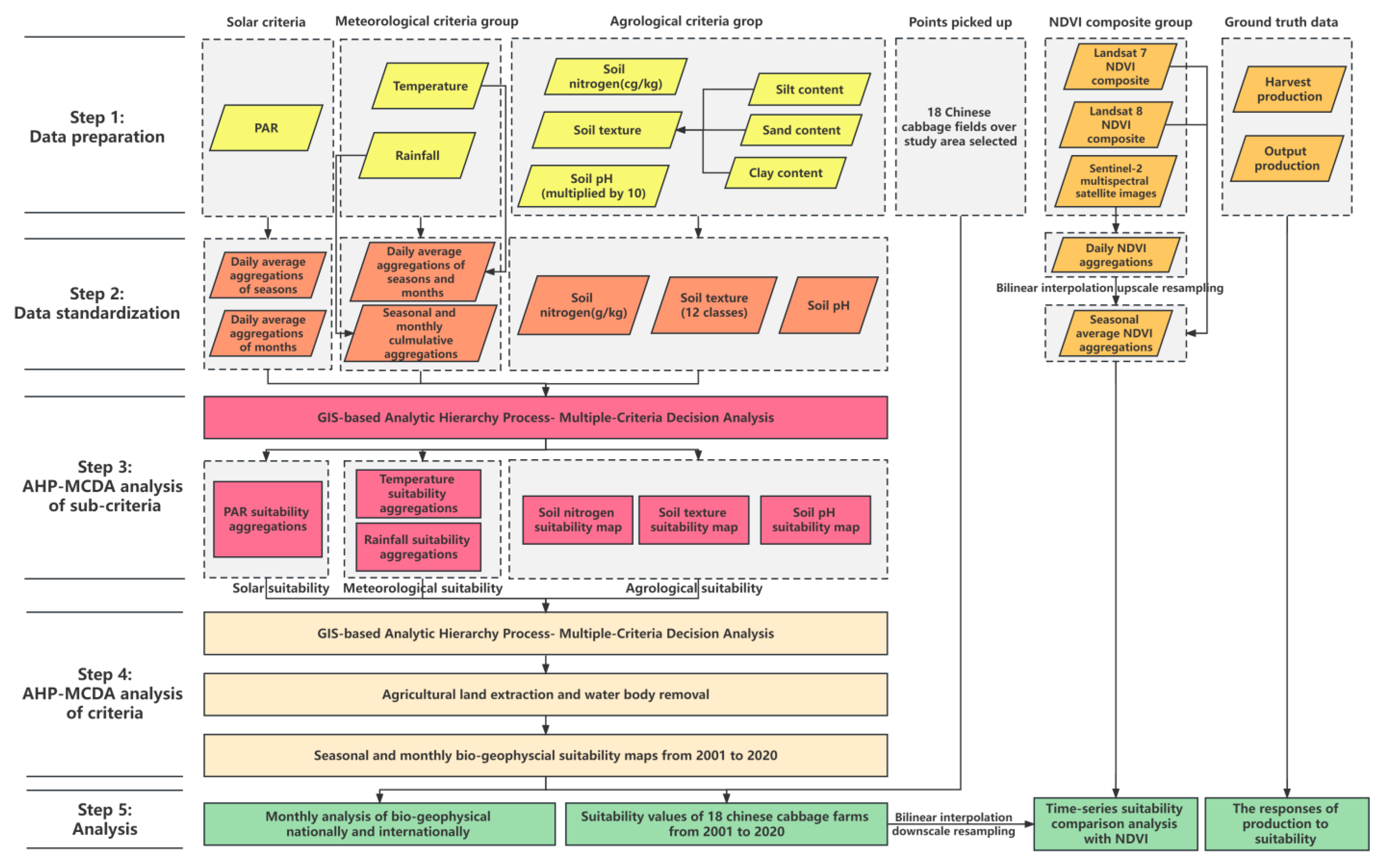
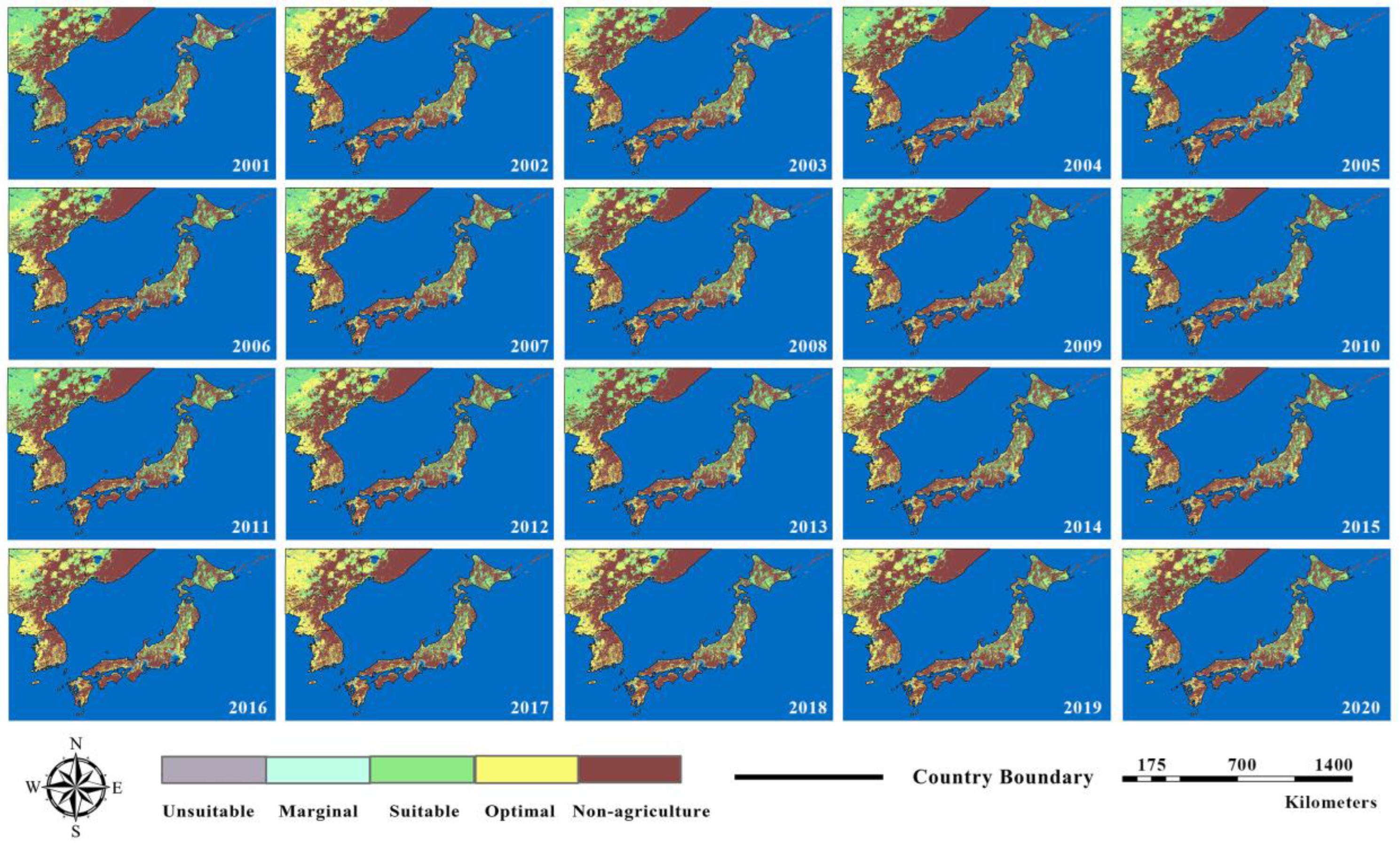
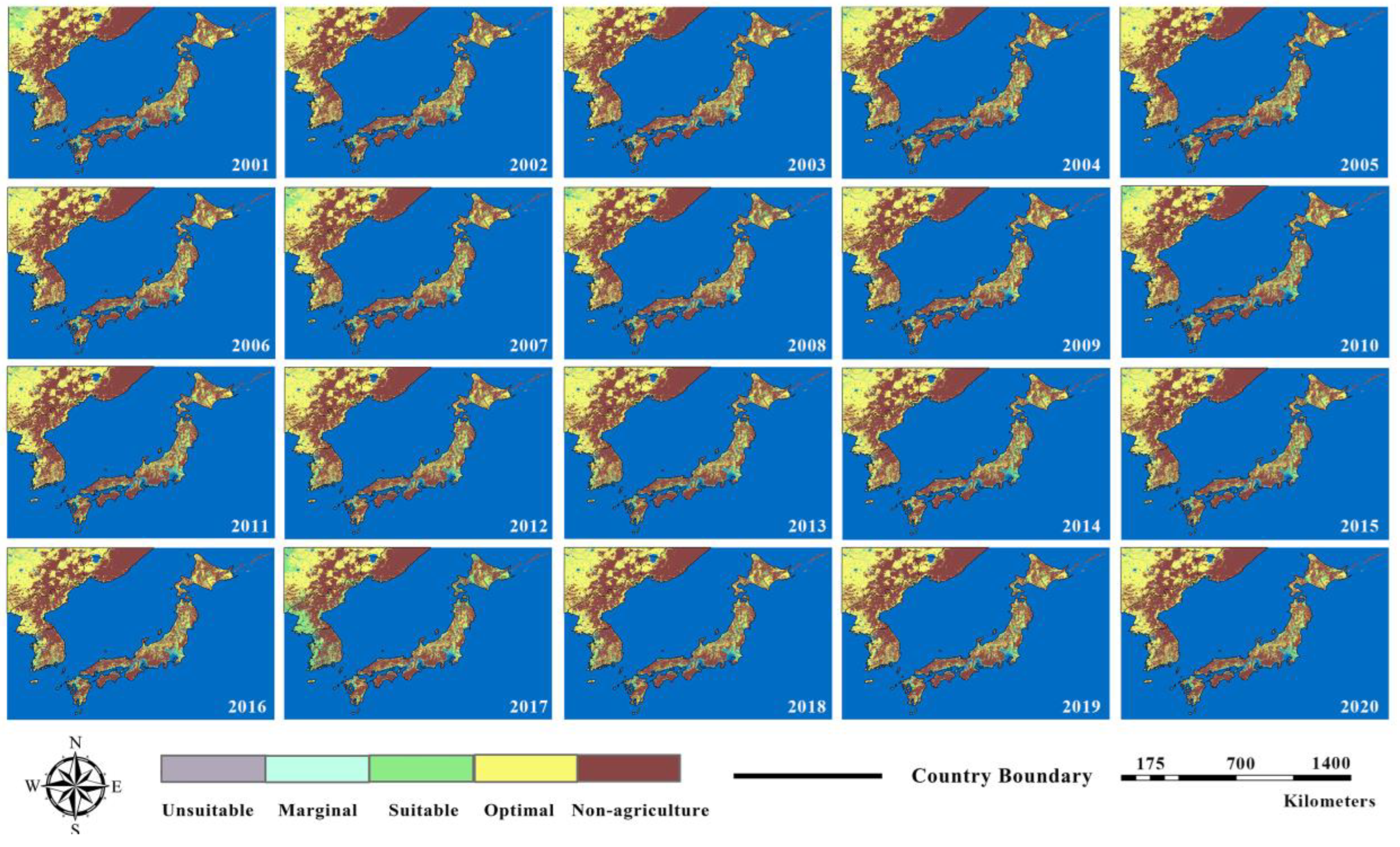
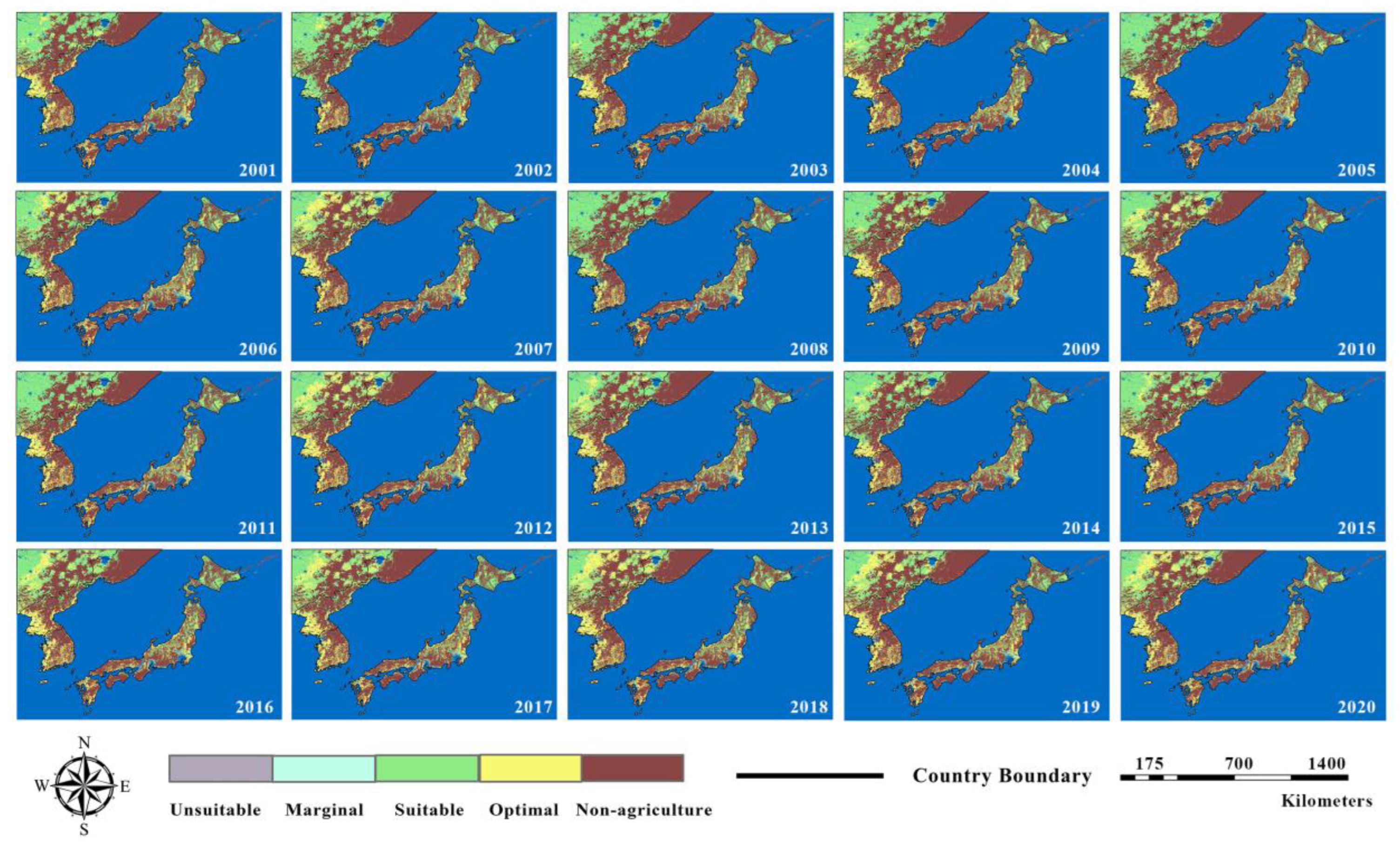
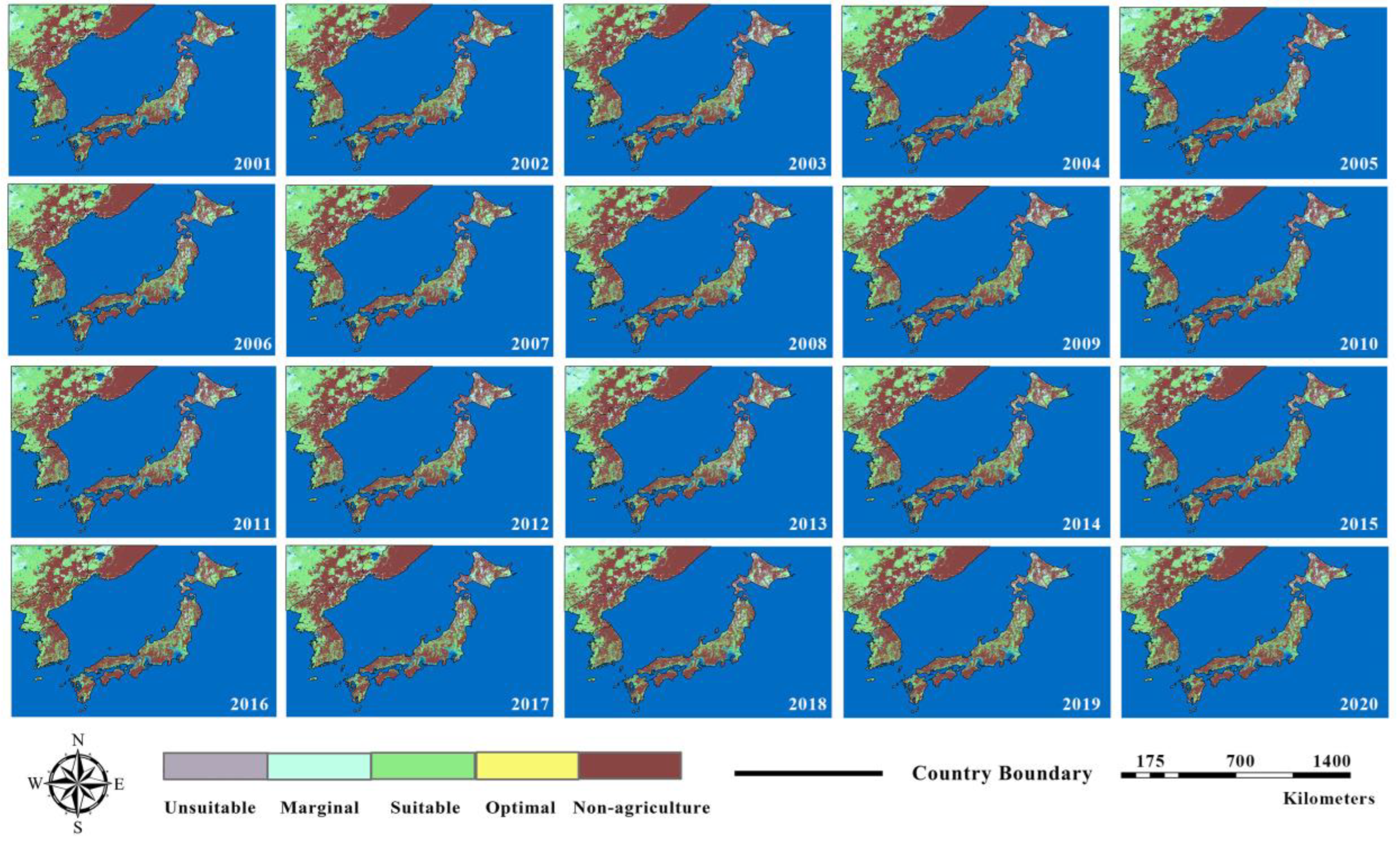
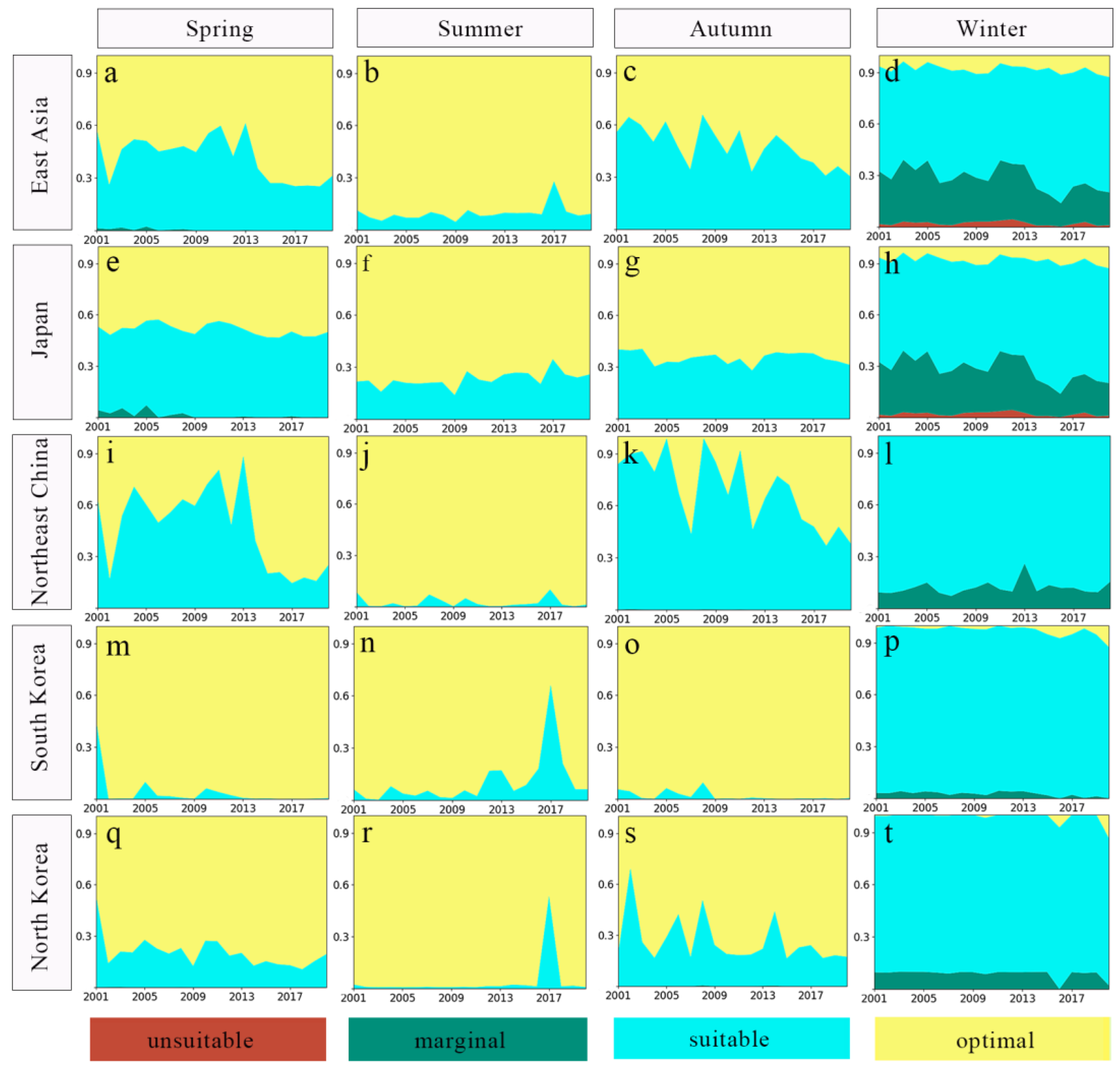
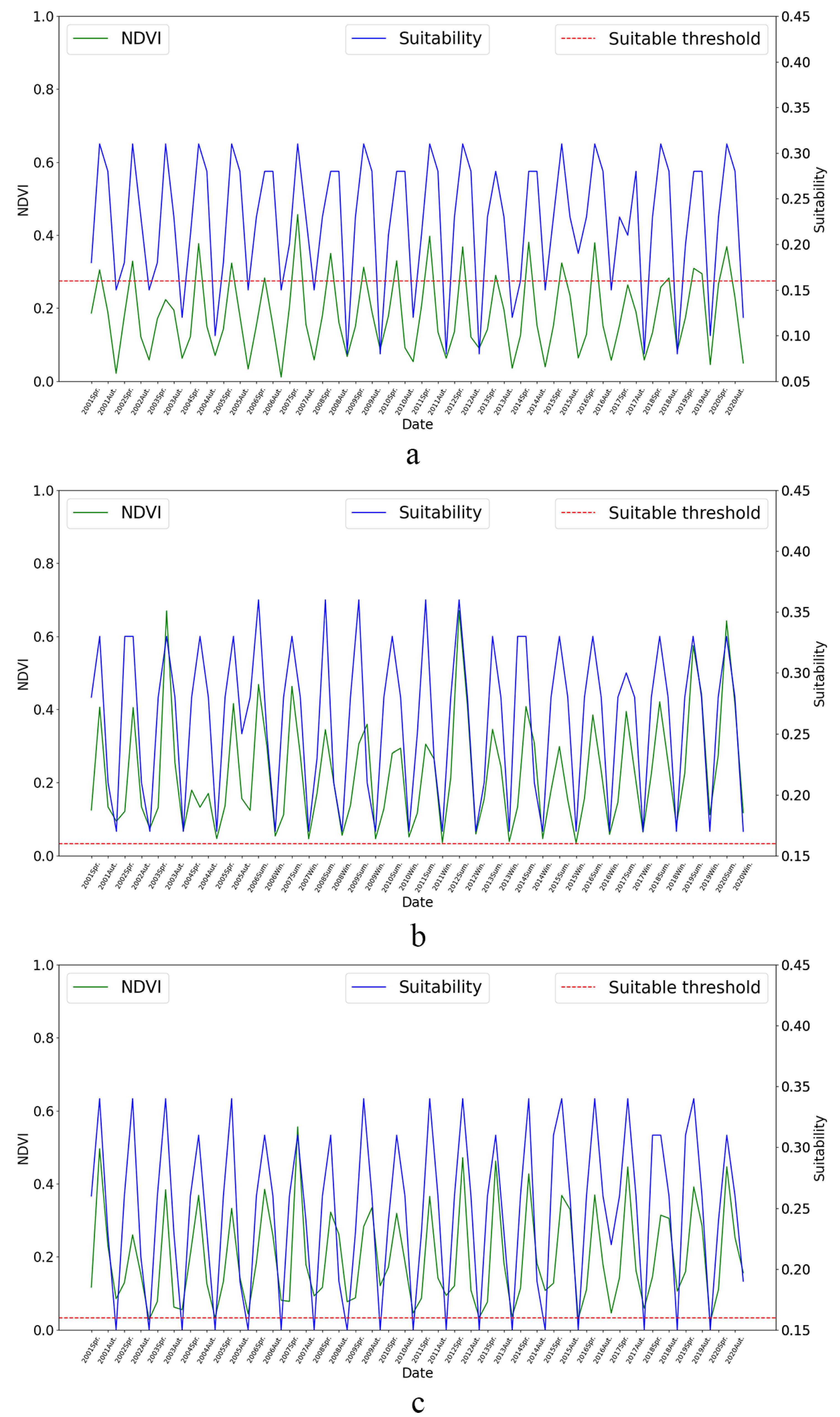
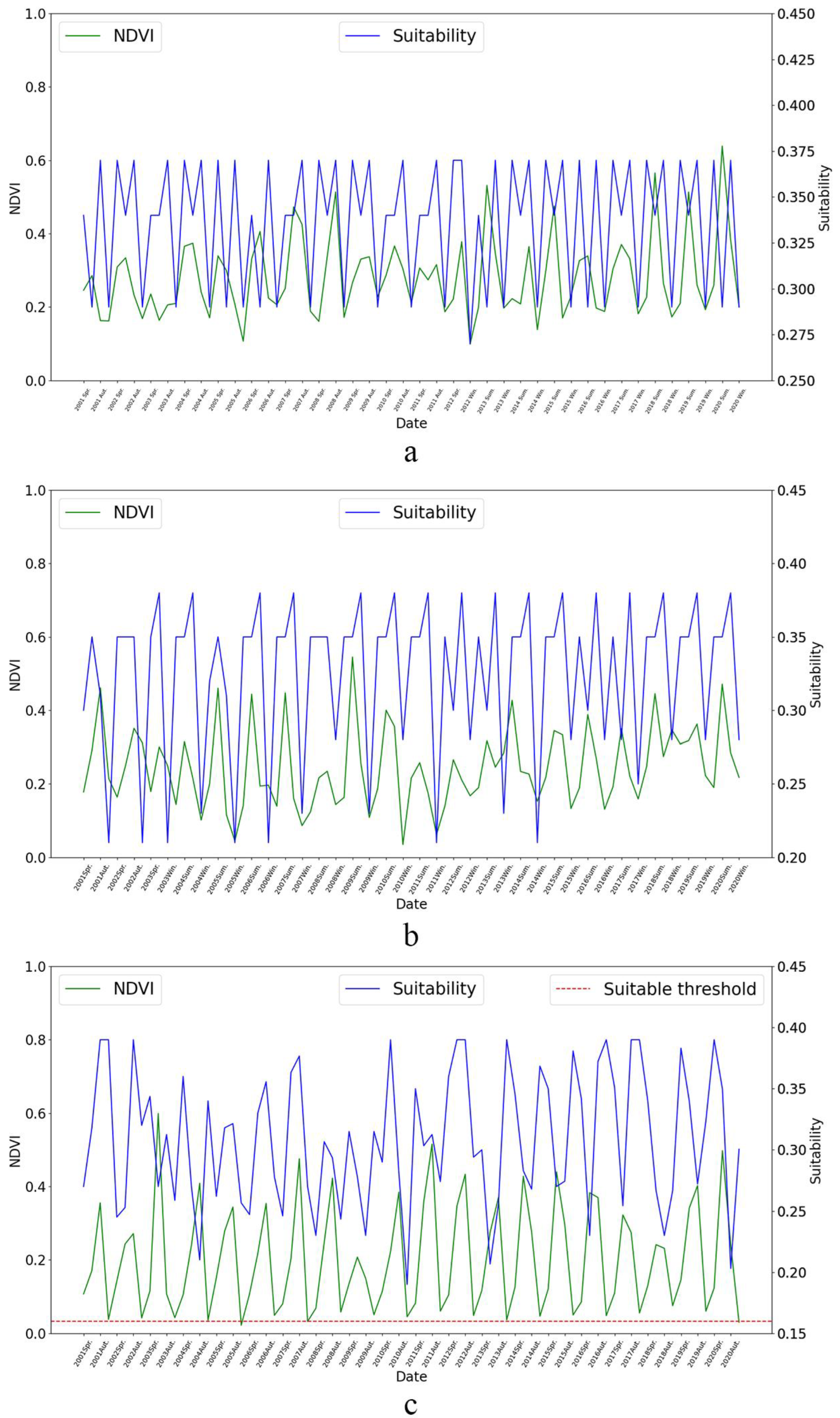
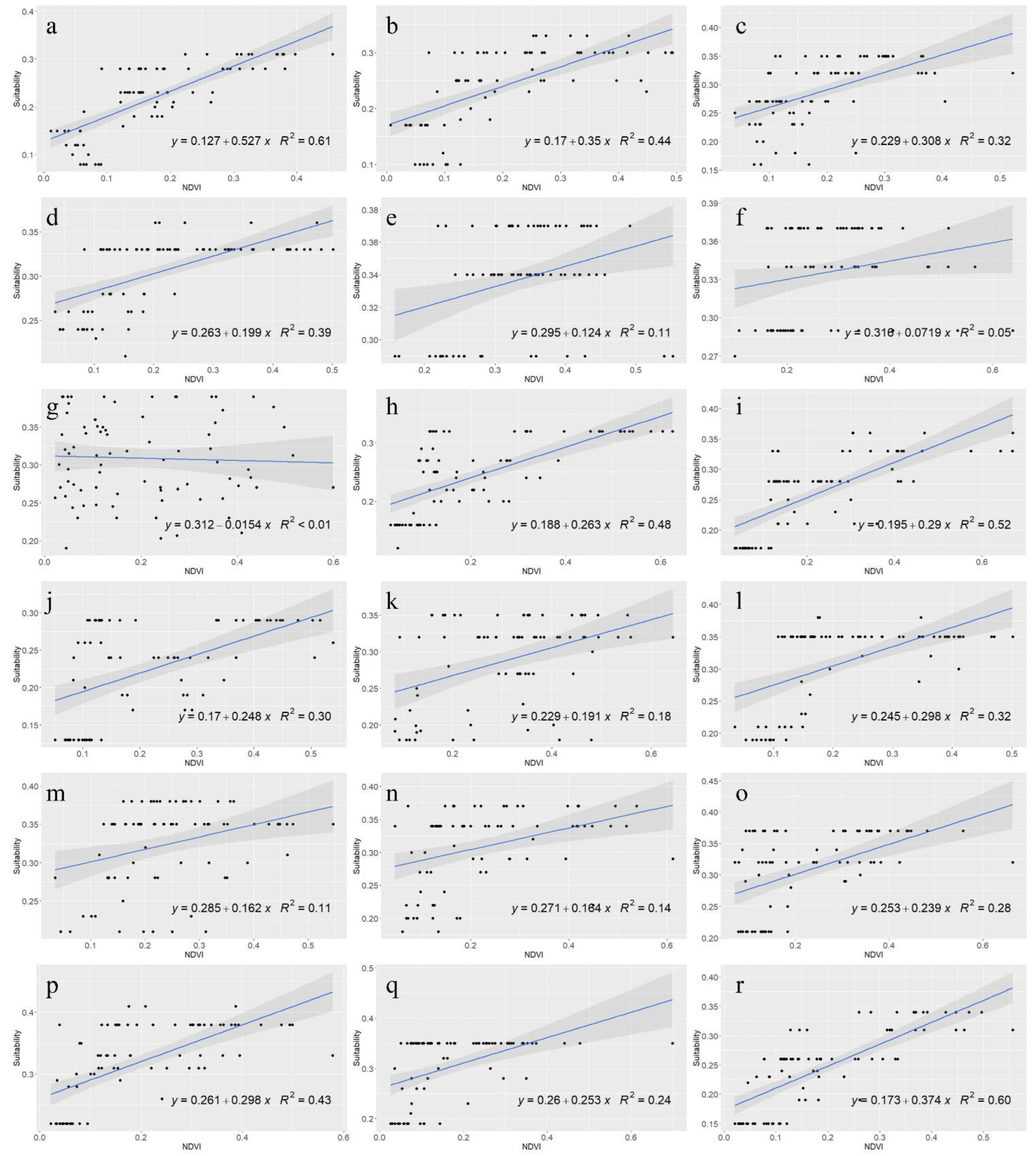
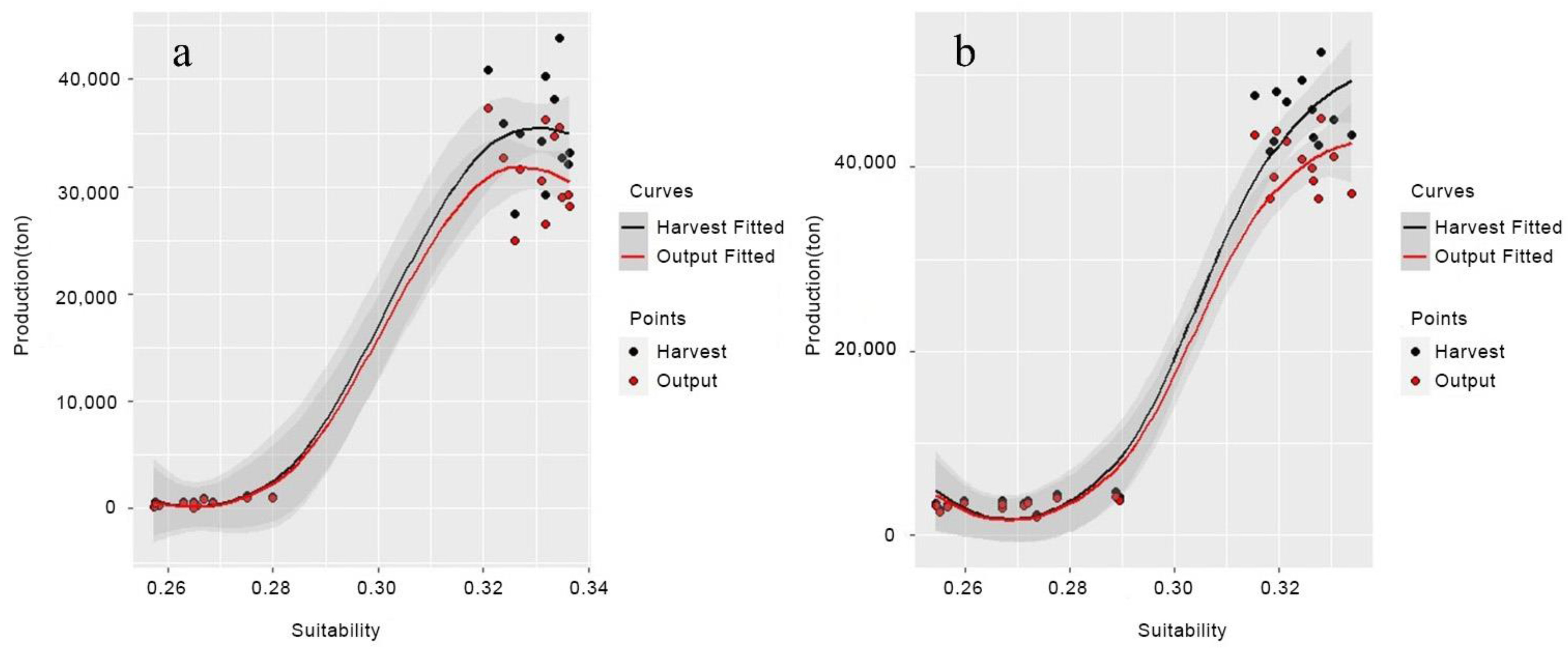

| Data | Source | Product | Temporal Range | Temporal Resolution | Spatial Resolution |
|---|---|---|---|---|---|
| Temperature | NASA MODIS | MOD11A2 v006 | 18 February 2000 to present | 8 days | 1 km |
| Rainfall | JAXA | Near Real Time | 1 January 2000 to present | 1 h | 0.1 degree |
| PAR | NASA MODIS | MCD18A2 v006 | 18 February 2000 to present | 1 h | 1 km |
| Soil nitrogen | WoSIS | Soil Grids 250 m 2.0 | 2017 to present | 250 m | |
| Soil texture | WoSIS | Soil Grids 250 m 2.0 | 2017 to present | 250 m | |
| Soil pH | WoSIS | Soil Grids 250 m 2.0 | 2017 to present | 250 m | |
| Agricultural land extraction and water body removal | NASA MODIS | MCD12Q1.006 MODIS Land Cover Type Yearly Global 500 m | 1 January 2001 to 1 January 2020 | 8 days | 500 m |
| GFSAD1000 | Cropland Extent 1 km Multi-Study Crop Mask, Global Food-Support Analysis Data | 1 January 2010 | 1 km | ||
| Glob Cover | Global Land Cover Map | 1 January 2009 to 1 January 2010 | 3 days | 300 m | |
| USGS Landsat | Hansen Global Forest Change v1.9 | 1 January 2000 to 1 January 2021 | 8 days | 30.92 m | |
| NDVI composite | USGS | Landsat 7 Collection 1 Tier 1 8-Day NDVI Composite | 1 January 1999 to 27 December 2021 | 8 days | 30 m |
| USGS | Landsat 8 Collection 1 Tier 1 8-Day NDVI Composite | 7 April 2013 to 1 January 2022 | |||
| ESA | Sentinel-2 MSI: Multispectral Instrument, Level-2A | 28 March 2017 to present | 10 days | 10 m |
| Criteria | Temperature | Rainfall | PAR | Soil Nitrogen | Soil Texture | Soil pH | Weight | CR |
|---|---|---|---|---|---|---|---|---|
| Temperaure | 1 | 2 | 2 | 3 | 3 | 3 | 0.32 | 0.008 |
| Rainfall | 1/2 | 1 | 1 | 2 | 2 | 2 | 0.19 | |
| PAR | 1/2 | 1 | 1 | 2 | 2 | 2 | 0.19 | |
| Soil nitrogen | 1/3 | 1/2 | 1/2 | 1 | 1 | 1 | 0.1 | |
| Soil texture | 1/3 | 1/2 | 1/2 | 1 | 1 | 1 | 0.1 | |
| Soil pH | 1/3 | 1/2 | 1/2 | 1 | 1 | 1 | 0.1 |
| Criteria | Sub-Criteria | Weight | CR | |
|---|---|---|---|---|
| Temperature (°C) | 15–20 | 0.41 | 0.008 | 0.1312 |
| 10–15, 20–25 | 0.31 | 0.0992 | ||
| 5–10, 25–30 | 0.16 | 0.0512 | ||
| 0–5, 30–35 | 0.08 | 0.0256 | ||
| <0 and >35 | 0.04 | 0.0128 | ||
| Rainfall (mm) | >100 (* >50) | 0.41 | 0.029 | 0.0779 |
| 80–100 (* 40–50) | 0.26 | 0.0494 | ||
| 70–80 (* 35–40) | 0.16 | 0.0304 | ||
| 60–70 (* 30–35) | 0.11 | 0.0209 | ||
| <60 (* <30) | 0.06 | 0.0114 | ||
| sPAR (W/) | >197.5 | 0.46 | 0.070 | 0.0874 |
| 118–197.5 | 0.27 | 0.0513 | ||
| 7.9–118 | 0.14 | 0.0266 | ||
| 3.95–7.9 | 0.09 | 0.0171 | ||
| <3.95 | 0.04 | 0.0076 | ||
| Soil nitrogen (g) | 180–260 | 0.41 | 0.076 | 0.041 |
| 140–180, 260–300 | 0.31 | 0.031 | ||
| 100–140, 300–340 | 0.16 | 0.016 | ||
| 60–100, 340–380 | 0.08 | 0.008 | ||
| <60, >380 | 0.04 | 0.004 | ||
| Soil texture | Loam | 0.48 | 0.022 | 0.05 |
| Sandy clay, silty clay, silt | 0.27 | 0.027 | ||
| Sandy clay loam, silty clay loam, clay loam | 0.17 | 0.017 | ||
| Loamy sand, sandy loam, silty loam, sil loam, sand | 0.08 | 0.008 | ||
| Soil pH | 6.5–7.0 | 0.49 | 0.086 | 0.05 |
| 6.0–6.5, 7–7.5 | 0.26 | 0.026 | ||
| 5.5–6.0, 7.5–8.0 | 0.14 | 0.014 | ||
| 5.0–5.5, 8.0–8.5 | 0.07 | 0.007 | ||
| <5.0, >8.5 | 0.04 | 0.004 |
| Categorization | Intervals |
|---|---|
| Optimal | 0.29–0.44 |
| Suitable | 0.16–0.29 |
| Marginal | 0.08–0.16 |
| Unsuitable | 0.03–0.08 |
Disclaimer/Publisher’s Note: The statements, opinions and data contained in all publications are solely those of the individual author(s) and contributor(s) and not of MDPI and/or the editor(s). MDPI and/or the editor(s) disclaim responsibility for any injury to people or property resulting from any ideas, methods, instructions or products referred to in the content. |
© 2023 by the authors. Licensee MDPI, Basel, Switzerland. This article is an open access article distributed under the terms and conditions of the Creative Commons Attribution (CC BY) license (https://creativecommons.org/licenses/by/4.0/).
Share and Cite
Shao, S.; Takeuchi, W. Bio-Geophysical Suitability Mapping for Chinese Cabbage of East Asia from 2001 to 2020. Remote Sens. 2023, 15, 1427. https://doi.org/10.3390/rs15051427
Shao S, Takeuchi W. Bio-Geophysical Suitability Mapping for Chinese Cabbage of East Asia from 2001 to 2020. Remote Sensing. 2023; 15(5):1427. https://doi.org/10.3390/rs15051427
Chicago/Turabian StyleShao, Shuai, and Wataru Takeuchi. 2023. "Bio-Geophysical Suitability Mapping for Chinese Cabbage of East Asia from 2001 to 2020" Remote Sensing 15, no. 5: 1427. https://doi.org/10.3390/rs15051427






